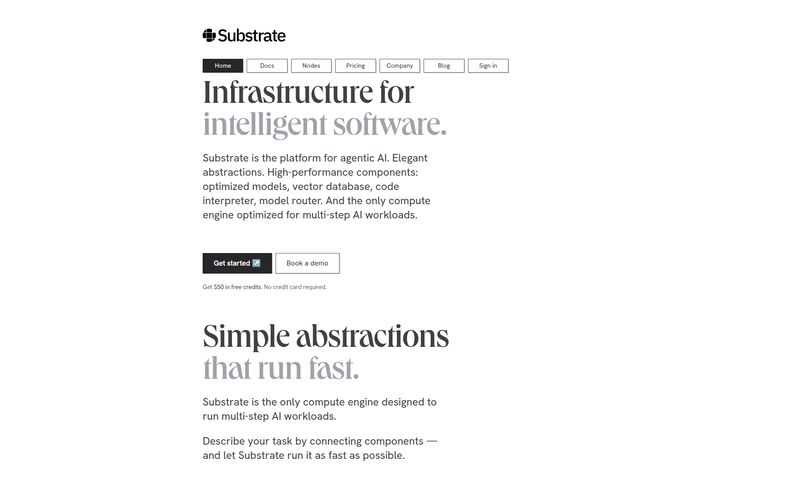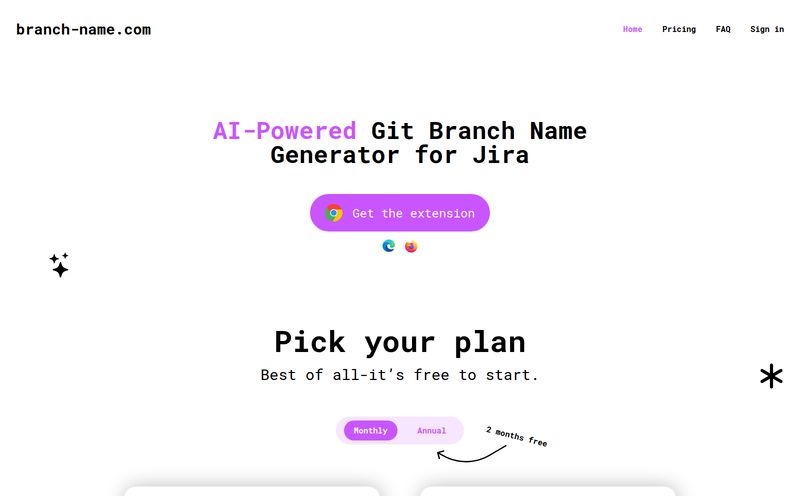We all got into software development to solve big, meaty problems. To build cool stuff. To architect elegant systems. What we didn't sign up for was the endless parade of tiny bug fixes, updating dependencies, or handling those small, nagging feature requests that clog up the backlog.
It’s the digital equivalent of death by a thousand papercuts. Each one is small, but together, they bleed your productivity dry. For years, we've been promised AI saviors, and while some are good, they often feel like blunt instruments. They're noisy, get in the way, or have privacy policies that make you... uncomfortable.
So when I stumbled upon Sweep AI, I was skeptical. Another AI assistant? Groundbreaking. But this one felt a little different. It's not just an autocomplete on steroids; it positions itself as an AI assistant that tackles chores directly in GitHub and integrates deeply with my beloved JetBrains IDEs. Could this be the one? I had to find out.

Visit Sweep AI
So What is Sweep AI, Really?
Think of Sweep less as a co-pilot and more like a super-efficient junior developer. Its main gig is to automate what it calls “software chores.” You file a GitHub issue for a bug fix or a minor feature, and Sweep gets to work. It reads the ticket, understands the context of your codebase, and then... it creates a whole pull request (PR) for you to review. Yeah, you read that right. It generates the PR.
This is a fundamental shift from just suggesting lines of code. It's about automating an entire, often tedious, workflow. But the magic, for me at least, really happens inside the IDE. As a long-time PyCharm and IntelliJ user, I'm picky about my plugins. They have to feel native, fast, and, frankly, smart. Sweep’s JetBrains plugin aims to do just that, bringing that same chore-automating intelligence directly into your coding environment.
The JetBrains Integration is the Real Star
Let’s talk about that plugin. Sweep calls their autocomplete experience “Tab Tab Tab in JetBrains.” And honestly, that’s a pretty good description. Their “Next-edit autocomplete” feels more intuitive than some other tools I've tried. It uses the context of your previous changes to suggest the next logical step, not just the most statistically probable line of code.
I was working on a small refactor in a Python project inside PyCharm, and the suggestions were genuinely helpful. It felt less like an interruption and more like a quiet partner anticipating my next move. One of the testimonials on their site from Josiah Parappally says the “Next-edit autocomplete in PyCharm is an absolute game changer,” and I’m inclined to agree. It’s a subtle but powerful difference that leads to a smoother, less frustrating coding session. It just gets out of your way and works.
The Features That Actually Move the Needle
Lots of tools have a long list of features, but only a few really change your day-to-day. Here's what stood out to me with Sweep.
Automated Pull Requests are Kind of Magical
I can’t overstate this. The process of turning a ticket into a PR is where so much time gets lost—context switching, finding the right files, running tests, writing descriptions. Sweep’s ability to take a bug report like “The login button is misaligned on mobile” and generate a PR with a potential fix is a massive time-saver. Of course, it's not going to architect a new microservice for you. It's designed for those smaller, well-defined tasks. It's a scalpel, not a sledgehammer.
An Autocomplete That Respects Your Flow
The in-IDE experience is top-notch. It’s not just for Python in PyCharm; it works across the JetBrains family, including IntelliJ and Android Studio. The suggestions are smart, and I've found myself accepting them more often than not. It's a genuine productivity boost without the cognitive load of constantly fighting with your tools.
A Serious Stance on Privacy
Okay, this is a big one. In an era where we're all a bit paranoid about who's training on our proprietary code, Sweep’s policy is a breath of fresh air. For all tiers, including the free one, they have a “Zero Data Retention” policy and they state explicitly that “Sweep never trains on your code.” For any developer or company with sensitive IP, this is a non-negotiable feature, and Sweep delivers. That alone puts it ahead of a lot of the competition in my book.
Alright, How Much Does Sweep Cost?
This is always the million-dollar question, isn't it? Well, maybe not a million dollars. Sweep's pricing is actually pretty straightforward and, I think, quite fair. They have a three-tiered approach that scales nicely.
- Free: This is a genuinely useful free tier. You get 50 Chat and Agent actions per month and 500 autocomplete suggestions. It’s perfect for individual developers or for just trying it out to see if it fits your workflow. And yes, it includes the zero data retention policy.
- Pro: For $30 per month, you jump up to 500 Chat and Agent actions and, crucially, unlimited autocomplete. If you're a professional developer and find yourself clicking 'tab' a lot, this is the plan. The cost is easily justified by even a few hours of saved time each month.
- Enterprise: At $60 per month per user, this plan has the same limits as Pro but adds the all-important option for self-hosting. For larger organizations with strict compliance or security requirements, being able to host Sweep within your own VPC is a critical feature.
The Good, The Bad, and The Code
No tool is perfect. After spending some time with Sweep, here's my balanced take.
On the plus side, the productivity boost from automating small tasks and the excellent JetBrains integration is undeniable. It saves mental energy, which is our most valuable resource. And their commitment to privacy is a massive win.
On the other hand, it's not meant for huge, complex changes. If you need to refactor a core part of your application, you're still the one who's going to have to do the heavy lifting. This tool is for the chores, not the architectural deep thinking. It also requires JavaScript to run, which is a minor point for most but something to be aware of. Lastly, while their privacy policy is great, you should always be clear on any tool's data handling before feeding it your company's secret sauce.
Is Sweep AI a Worthy Addition to Your Toolkit?
In my experience, yes. If you're a developer working within the GitHub and JetBrains ecosystems, Sweep AI feels like a missing piece of the puzzle. It doesn't try to replace you. It tries to free you.
It takes the most annoying, repetitive parts of the job off your plate so you can focus on the work that actually matters. It's like having that perfect intern—eager, fast, and knows when to stay quiet. The free tier is generous enough that there's really no reason not to give it a spin. It might just be the productivity boost you didn't know you needed.
Frequently Asked Questions about Sweep AI
- 1. What exactly is Sweep AI?
- Sweep AI is an AI-powered assistant designed to automate software development chores. It can automatically fix bugs and implement small features by creating pull requests directly from GitHub issues. It also functions as an intelligent code completion tool inside JetBrains IDEs.
- 2. Is my code safe with Sweep AI?
- This is one of Sweep's strongest points. They have a strict Zero Data Retention policy and state that they never train their AI models on user code, for any pricing tier. For maximum security, the Enterprise plan offers a self-hosting option.
- 3. Does Sweep AI work with VS Code?
- Currently, Sweep AI's primary focus for IDE integration is the JetBrains suite, including IntelliJ, PyCharm, and Android Studio. They don't advertise a VS Code extension on their main site.
- 4. How does the automated bug fixing work?
- When you create a GitHub issue with a specific bug report or feature request, you can assign it to Sweep. The AI analyzes the ticket, reviews your codebase for context, and then attempts to write the necessary code changes, finally packaging it all up in a new pull request for a human developer to review and merge.
- 5. Is the free plan good enough to use long-term?
- For a solo developer or someone with a light workload, the free plan is quite capable. With 50 agent actions (like creating PRs) and 500 autocompletions per month, it provides a lot of value. Heavy users or professional teams will likely want to upgrade to the Pro plan for unlimited autocomplete.
- 6. Who is behind Sweep AI?
- Sweep AI is backed by the well-known startup accelerator Y Combinator, which lends it a good deal of credibility in the tech community.
Final Thoughts
Look, the AI tool space is getting crowded. It's noisy. But once in a while, a tool comes along that feels like it was designed by people who actually understand our workflow. Sweep AI feels like one of those tools. It's practical, privacy-focused, and genuinely useful. It won't write your whole app for you, and that’s a good thing. Instead, it gives you back your most precious asset: time. And that's a feature worth paying for.



